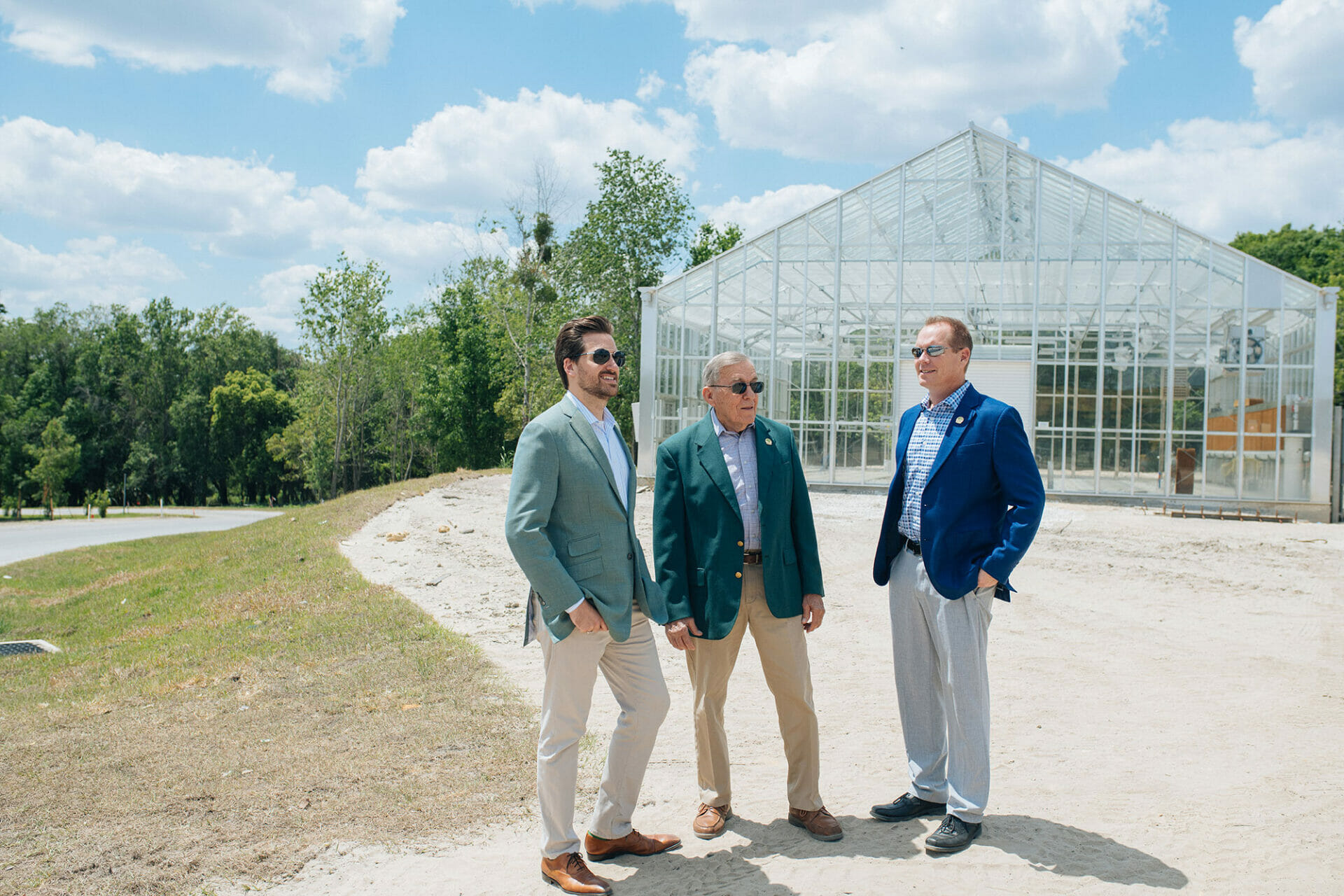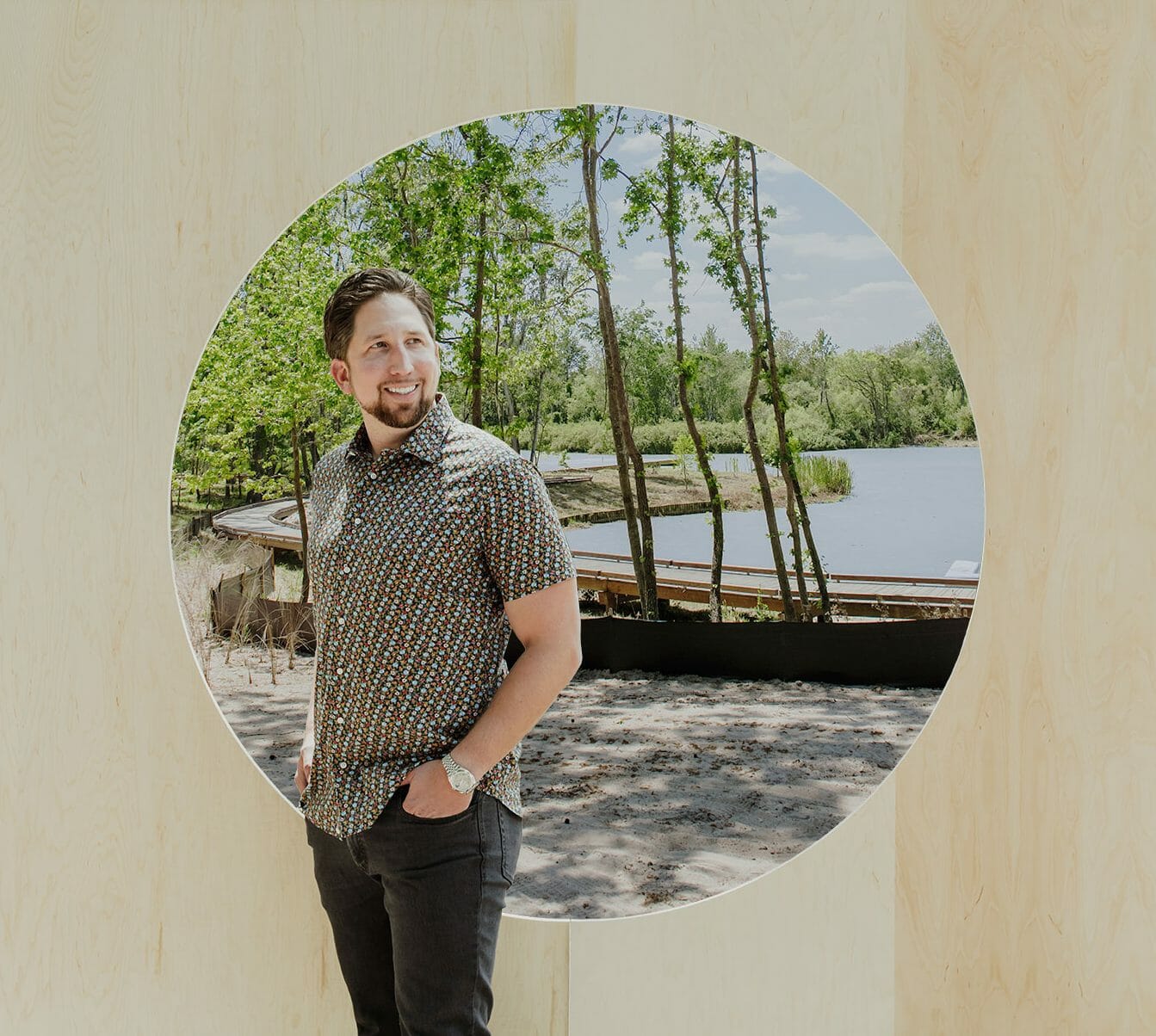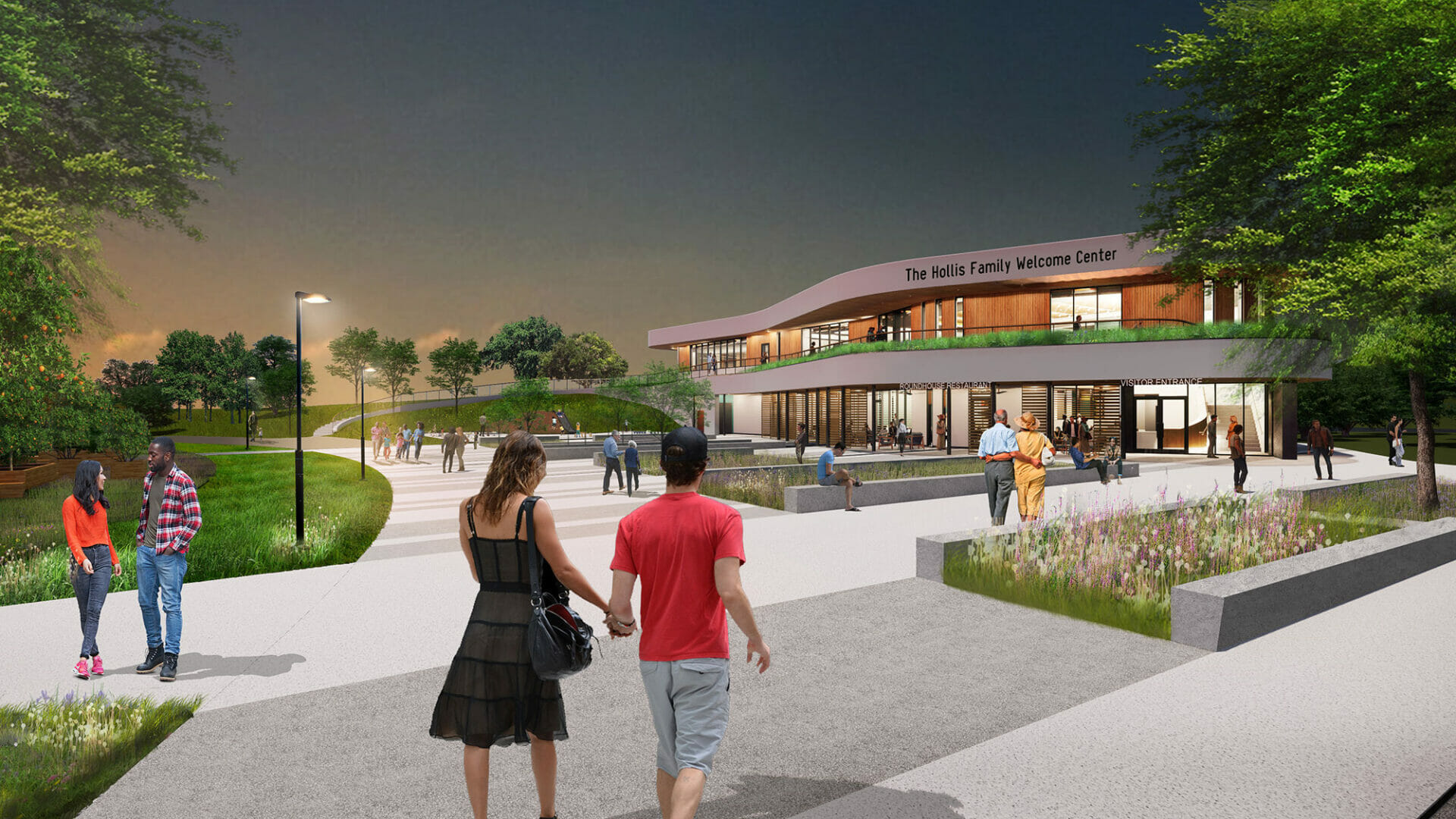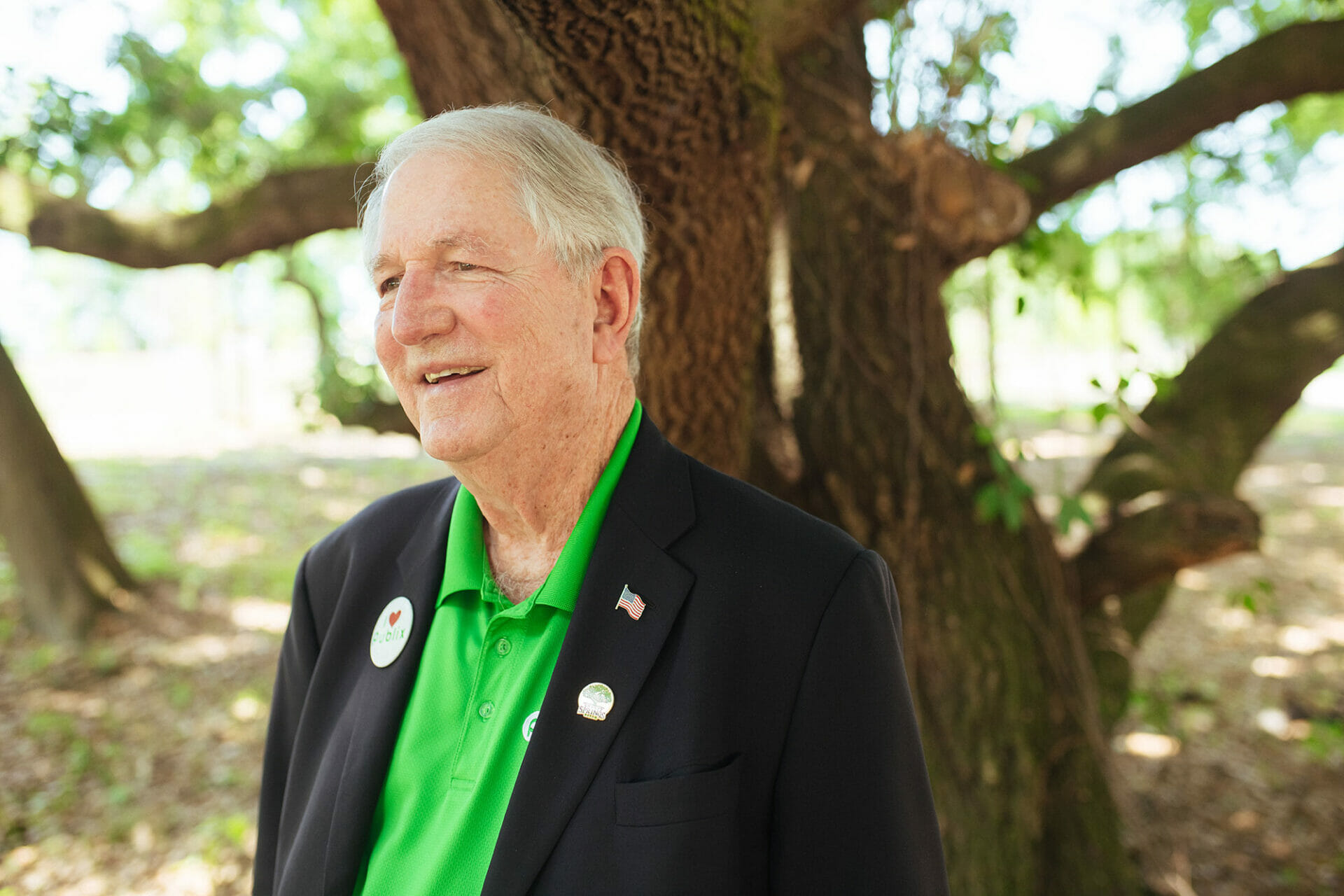Photography by Dan Austin
Transforming an abandoned railyard into an ecological jewel, a cultural magnet, and a connected community asset for Lakeland’s rapidly growing community.
Home to the Lakeland Railyard, these lands — located between West Memorial Boulevard and George Jenkins Boulevard on the east side of Lake Bonnet — served as a major hub for the movement of freight up and down the east coast between 1880 and the early 1950s, providing direct routes for Florida’s phosphate and agricultural industries. In 1952, the railyard closed, having served the purpose of connecting communities, cities, and states. Today, a team of local mavericks have a vision for repurposing the 168 acres near downtown that once helped Lakeland become the thriving city it is today.

The Harrell Family’s legacy gift of $1.3 million is designated to The Jack & Tina Harrell Family Botanical Garden and The Jack & Tina Harrell Family Greenhouse. Left to right, Nick Barnett, David Bunch, and Joshua Henderson.
“Bonnet Springs Park (BSP) will provide connections that spark an ecological renaissance in our community.” – Bonnet Springs Park website
With amenities like the Crenshaw Canopy Walk, GiveWell Community Foundation Nature Center, event lawn, walking and biking trails, boating activities at the Ann and Ward Edwards Boathouse, and Harrell Family Botanical Garden, the Park will exist to help enrich our community through nature, culture, recreation, and education. The Park will support physical and social equity, in an effort to reinforce shared experiences and forge new connections within our growing and changing community.

Bill Tinsley, President
Over the past few years, Lakeland’s central location has piqued the interest of many large corporations and their need for centralized distribution centers. “I was worried about this piece of property. I knew what was going on in Lakeland. It was becoming a distribution center, and you’re seeing it all over the place. Half a million to a million-square-foot warehouse are going up. And I knew this would become one of those if we didn’t capture it,” says local developer David Bunch, who also serves on the board of directors for Bonnet Springs Park.
“This blended urban/natural park will provide spaces to escape, engage, and explore with one another and with nature while experiencing and learning about the extraordinary history of Central Florida.”
Bunch was involved with the railyard property 45 years ago when he first recognized it as prime real estate, and its use at the time was not conducive to the future expansion of downtown Lakeland. “In the ’70s, I spoke to [CSX] about moving off the yards. And, in the early ’80s, they did,” says Bunch. By the mid-’80s, Bunch and CSX launched a joint venture to develop the railyard into a high-end business park that included a public green space/park. Upon clearing the land and preparing the foundation for these plans, the recession of the ’80s took place and the project came to a halt. During that time, Bunch decided to sign over his investment in the property back to CSX, and the property was abandoned for 25-plus years with CSX as the rightful owner.
[pull quote] “I see this Park as a means to truly bring the Lakeland community together in a way unlike any other. Our hope is that, through this Park and its features, we will create an experience in which all people will want to participate.” – Nick Barnett
In 2015, recognizing that metro Lakeland was one of the fastest-growing regions in the country, and building upon the city’s strong tradition of green spaces, Bunch and Bill Tinsley began envisioning what Bonnet Springs Park should be. Tinsley, the former City of Lakeland Parks and Recreation Director, devoted his career to creating great parks and joined the project as the lead in the master plan process.
“A place within walking distance to our city’s urban core where art, recreation, fun, and tranquility intersect by design. This blended urban/natural Park will provide spaces to escape, engage, and explore with one another and with nature while experiencing and learning about the extraordinary history of Central Florida.” – Bonnet Springs Park website
Bunch, and his wife, Jean, presented this big concept to philanthropists Carol and Barney Barnett, generous benefactors who care about the future of Lakeland. With this vision in mind, the Tinsley and Bunch families — alongside the Barnetts who were joined by sons Wesley and Nicholas Barnett — added a 14-person advisory committee which consisted of a diverse group of local community advocates. Together, they agreed to develop the railyards and available nearby properties to create an urban oasis for Lakelanders.
Recovering these lands was no easy feat; CSX saw value in the location of the land. “We flew up to Jacksonville, Florida, and put time into cultivating a philanthropic relationship with CSX, during which we were able to build a plan with them that was mutually beneficial so that we were able to acquire the land.” Eventually, they came to a sales agreement, and, upon purchasing the land from CSX, “We drew up an agreement to properly remediate the land and clean it up,” says Barney Barnett.

Wesley Barnett, Board of Directors
The land was an industrial site. “[The railyard] left its mark on the land, and we had to remediate the site and bring it under a Brownfield classification,” explains Tinsley. Preparing to develop the site required partnering with a world-renowned architectural and Park-planning group. “We were looking for a group that could ‘be sensitive to the land’ and help us convert this previous Brownfield site into a jewel,” says Tinsley.
In 2017, the Bonnet Springs Park Board of Directors hired a Boston-based design firm, Sasaki, to create a master plan for the Park, heal the environmental damage that came from years of industrial use, and ultimately help transform the site into an urban oasis. Sasaki’s first step was to take input from the public during a six-month outreach period and incorporate ideas and desires into an approved design and Park mission: to become an ecological jewel, a cultural magnet, and a connected community asset.

The park will feature casual and upscale dining options in addition to a beer garden.
Sasaki’s knowledge and experience were extremely helpful when the Bonnet Springs Park team discovered that 300 acres of offsite water was draining from Kathleen Road onto the property through a concrete flume.
“With that, elevation changes on the property had jettisoned down a ravine that was probably 30 feet deep. This caused every rain event to bring plastics and garbage from industrial, residential, and three state roads onto the property; it had been doing this for 50 years,” says Tinsley. That same dirty water was carrying garbage and traveling through Lakeland and ending up in Lake Bonnet and even the Hillsborough River in Tampa.
Sasaki’s team of engineers created a filtration system to capture the solids and resolve the issue.
“We relocated, captured that water, and moved it through a vault that separates those solid materials. And now it is actually conveyed through a series of three ponds before it goes into a lagoon,” says Tinsley. “The filtration through those ponds allows the nutrients to be taken out by the 28,000 plugs they added. Now, the water, which was a terrible challenge, has become clean, usable water. And we use that water as a sustainable model to irrigate the Park. That’s our primary source of irrigation for the entire Park.”
Bonnet Springs Park will welcome visitors of all ages and backgrounds from throughout the city. It will connect neighborhoods that are currently divided by transportation infrastructure and a gap in the urban fabric.
“[Sasaki] did an incredible job in the community with focus groups that we put together, including all the public and state agencies, and so forth. They helped guide us through that myriad of what Lakelanders really want to support in this Park,” says Tinsley.
“I see this Park as a means to truly bring the Lakeland community together in a way unlike any other. Our hope is that, through this Park and its features, we will create an experience in which all people will want to participate. We have often referred to Bonnet Springs as ‘Lakeland’s Central Park,’ and though I recognize that our project is not on the same scale as Central Park, my hope is that people will come to see it as an inseparable part of Lakeland in the same way that New Yorkers see Central Park,” says Nick Barnett.

Registered as a 501(c)(3) organization, Bonnet Springs Park is a privately funded, Urban Park that depends solely on public support. There are multiple levels of giving opportunities in addition to volunteer opportunities for everyone. “Volunteers are going to be a huge, important asset for us to maintain this Park, because we’re not going to settle for this Park to be maintained for anything other than first class,” says Barney Barnett.
The Park offers a variety of volunteer opportunities in many fields of interest, from gardening to arts and history. Bonnet Springs Park hopes to inspire people to be a part of this project and the community for years to come. Whether it’s answering phones or helping seniors with a newfound meaning to life, “We’ve got plenty of volunteer opportunities. And volunteerism, as we said, is extremely important,” says Tinsley.
Giving opportunities range from $50 to $5 million, which includes a number of naming opportunities for major gifts. The estimated cost of creating and maintaining this transformational Park is between $110-$120 million, of which over 70 percent has already been committed, with a capital campaign underway to raise the balance, and many dedicated volunteers.

Barney Barnett, Chairman of the Board
While the Park is privately funded, its programmatic elements are intentionally designed to generate income. “The Park will have revenue streams that offset the number of dollars that are needed to operate the Park on an annual basis,” says Josh Henderson, CEO of Bonnet Springs Park.
For example, the Explorations V Children’s Museum will charge an admission fee. The Event Lawn and areas will host outdoor concerts, events, and festivals, while other facilities, like the GiveWell Community Foundation Nature Center, Event Center, and Hollis Family Welcome Center will boast a cafe, multipurpose rooms for event rental, and the Citizens Bank & Trust Ballroom that seats up to 400 for weddings, corporate events, and other large gatherings.
“The possibilities for how this space can be utilized are virtually endless. The sort of events we are likely to see on a regular basis are concerts, fairs, conventions, and to a lesser extent, possibly private or corporate events. We will do our best to ensure that there is a certain degree of programming throughout the year and work with community partners to develop culturally relevant programming. We want to have a healthy mix of special events, without compromising the experience of our regular visitors who simply want to come and enjoy the natural beauty of the Park,” says Nick Barnett.
Together with the community, the Bonnet Springs Park leadership team is excited to make the dream of this project a reality for Central Florida’s future generations to enjoy. The Park will present natural beauty and a wide array of activities that invite the community to “Escape. Engage. Explore.”
Bonnet Springs Park
1025 George Jenkins Boulevard
Lakeland, FL 33815
bonnetspringspark.com


